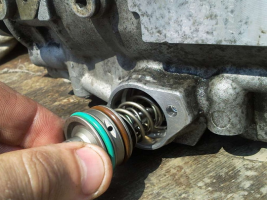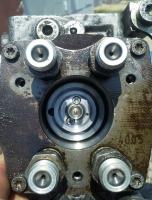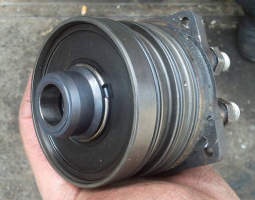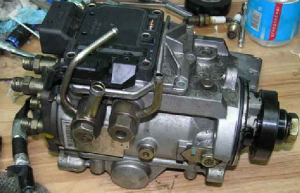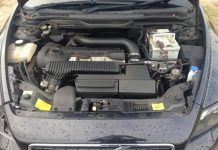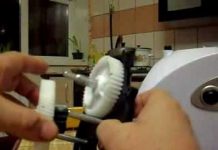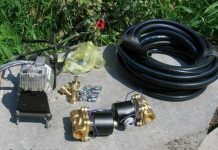In detail: DIY repair of diesel fuel equipment from a real master for the site my.housecope.com.
There is no more complex and critical unit in a diesel engine than the fuel injection system, more precisely, its main part - the high-pressure fuel pump. Many mating parts, high-loaded units, the presence of a precision dosing system, make the repair of the injection pump a difficult task even in service conditions. It is all the more difficult to repair the high pressure fuel pump of a diesel engine with your own hands.
In automotive technology, almost everything is repaired, except, perhaps, individual oil seals and cuffs, the repair of which is impossible without special materials. The complexity of setting, diagnosing and repairing the injection pump requires the employee to have skills in working with precision mechanics.
It is simply impossible to adjust according to the factory parameters, without a special diagnostic stand for the repair of the injection pump. In the course of a diagnostic study of the injection pump, it is necessary to check:
- cyclic supply of the high-pressure pump, in the entire range of revolutions of the injection pump shaft, at start-up, and after cutting off the fuel supply;
- stability of the developed pressure;
- uniformity of the injection pump delivery to the fuel injector.
Even having access to a diagnostic stand, and having studied the issue of repairing a high-pressure fuel pump using numerous videos, it is very difficult to qualitatively check and evaluate its work.
In heavy diesel engines, plunger, in-line injection pumps are used. In maintenance and repair, such devices are more difficult, since they require special equipment for its disassembly, therefore we will not consider such high pressure fuel pumps and their repair.
In a passenger diesel engine, a distribution type injection pump is almost always used. Unlike an in-line pump, in a distribution pump, the force is transmitted to the plunger using a profiled cam washer. The design of the injection pump turned out to be more compact, but it is hardly simpler to expect to carry out its repair on the knee.
| Video (click to play). |
The most famous and affordable is the Bosh VP44 injection pump. Often, the need to repair the pump internals arises when:
- poor traction and incomplete combustion of fuel even under ideal conditions - in the absence of load and a thoroughly warmed up engine;
- a sudden failure and stoppage of a diesel engine under load, which is called “death on takeoff”. Usually the scanner in such cases diagnoses the code P1630 and P1651.
- the appearance of a diesel fuel leak in the area of the gland seal of the central shaft of the injection pump.
Therefore, we will restrict ourselves to the issue of repairing the injection pump with our own hands by replacing the seals and eliminating the scoring of the working surfaces of the parts.
Before disassembling the pump drive shaft seal, try to move it radially. If play is felt with your hands, it is possible that the reason for the leakage of fuel is the wear of the working surface of the shaft or requires repair of the bearing.
A large number of split planes and mating surfaces of parts required the use of a large number of seals and glands. As a rule, they are made of quality material and last long enough until they are damaged during repair or maintenance. In this case, standard repair kits are used for DIY repair of Bosch injection pumps.
It is quite easy to replace the seal on the shaft position sensor and on the automatic injection timing during repairs. For a better fit, you can drip a few drops of spindle or engine oil onto new rings and rubber bands.
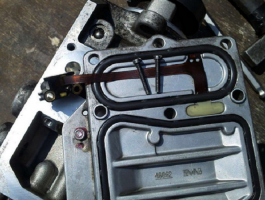
For preventive repair of a Bosch injection pump with your own hands, you will need to disassemble the pump in approximately the following order:
- remove the metering valve from the end of the injection pump. To do this, unscrew the four screws of the pressure plate, carefully release the cable of the injection advance valve. By removing the three screws securing the metering valve, you can carefully remove it from the seat;
- by unscrewing the fastener on the top cover, you can remove the control board and gain access to the electronics;
- we set the position of the shaft, as shown in the photo, remove the camera and get access to the insides of the injection pump;
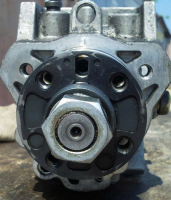
- after dismantling the bearing using a special puller, we get the opportunity to study the potential culprit for the poor performance of the injection pump - the piston of the injection advance unit. There is often surface wear and edge scuffing on the part. You can try to make repairs by polishing the surface, replacing the whole part is much more expensive.
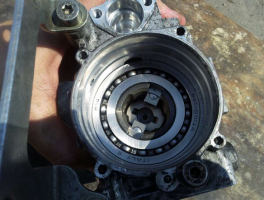
After the repair, the assembly is carried out in the reverse order with the washing of the parts with diesel fuel.
Often, in addition to scoring, on the surface of the pistons there is another reason why the injection pump does not develop the required pressure. This can be due to debris, films or wax build-up on the filter screen inside the pump. There is a mesh on the side of the inlet pipe. Rinsing the channels is a troublesome and ineffective business, it is easier to remove the mesh and blow it with compressed air.
Torn pieces of debris can jam the plunger piston or even break or break the pump drive shaft. Therefore, cleaning should be done very carefully to avoid contamination of the internal cavities of the pump.
Among the many reasons for the failure of the electronic "liver" of the injection pump, the most common is the breakage or burnout of the contacts of the control board and the failure of power transistors. If the knowledge and skills of working with electronic devices allow to carry out a "continuity" of the transistor performance and repair, it is worth trying to identify the cause and replace the culprit with a serviceable element.
To check the condition of the "culprit", you need to carefully open the black cover, which is tightly seated on the rubber seal with screws. It should be removed carefully so as not to damage the seal itself.
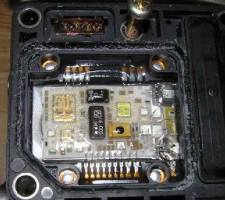
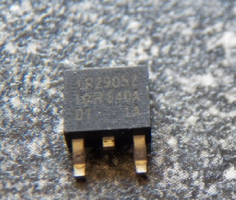
The reason for the failure of not only the transistor, but also the entire board could be air trapped in the cavity due to poor performance of the drainage system or the check valve. Often, they try to eliminate the airing by spinning up with a starter, hoping to pump diesel fuel into the high-pressure fuel pump in this way. At this moment, the transistor is open and loaded as much as possible, which leads to intense heating. In an air environment with poor heat dissipation, it will inevitably burn out. In some German cars there is a protection that prevents an attempt to start the engine in the absence of fuel in the highway. For this, a fuel sensor in the tank is used.
Failure of the transistor can be established by "dialing" a tester or by its appearance. The best option for repairing such a malfunction would be to replace the entire control board. Perhaps it is more expensive than soldering, but it will give guaranteed quality and stable operation of the injection pump after repair. As a last resort, give the board and the transistor for soldering to electronics specialists.
When installing and reassembling after repairs, check the tightness of all fasteners.
If during the audit you did not make rash and unreasonable replacements of parts, the assembled pump should work with approximately the same parameters as before. Bosch EPS-815 stand is used as a standard for testing and adjusting injection pump after overhaul.
The video shows how to raise the plunger pressure in a Bosch VE injection pump:
High pressure fuel pump in the diesel power system. Violations in the operation of the device, their external manifestations. How can you repair the pump on your own, the sequence of actions. Tips for using specialized services.
Any diesel engine may sooner or later require repair of the high pressure fuel pump. As the human heart begins to "junk" over the years, so this apparatus is subject to age-related changes. Along with the natural wear and tear of parts, refueling with low-quality fuel also affects. Diesel units are more sensitive in this regard than gasoline engines.
The proposed article will help the owners of diesel cars in case of problems with the fuel pump. It also provides tips on how to repair this unit yourself.
The high-pressure fuel pump (TNVD) is an independent unit of the power supply system for internal combustion engines (ICE), primarily diesel. Although this device is also used on petrol injection engines, it was first used on a diesel engine.
Its main function is to create a pressure difference between the pressure line and the compression chamber in order to ensure reliable injection of fuel into the cylinder cavity. But this is not enough.
The pump also sets the sequence for supplying fuel to the working injectors, that is, it performs a distribution function. In addition, it regulates the flow rate depending on the driving mode (crankshaft speed) and on some other factors: engine temperature, turning the air conditioner on and off.
Finally, just as the ignition timing is adjusted in carburetor engines, the injection pump on a diesel engine automatically adjusts the injection timing.
There are three main types of pumps: in-line, multipoint injection and mainline. Their device is considered in a separate article. It is worth mentioning here only that in-line pumps were used until recently on diesel trucks, tractors and specialized road transport equipment.
Switchgears are installed on all light diesel cars and some trucks. Trunk lines are used in modern Common Rail fuel systems. Such pumps are deprived of the function of fuel distribution; this task is performed by the electronic engine control unit (ECU), which, according to the program, commands the working injectors.
What are the signs of a malfunction of the fuel pump? As mentioned at the beginning of the article, the main reasons for the loss of performance of the high pressure fuel pump are wear of rubbing surfaces and low quality of fuel. Here you can clarify that the low quality of diesel fuel should also mean the ingress of water into the fuel. The following are the external symptoms of a malfunctioning fuel pump:
- It is difficult to start the engine - most likely, the plunger pair (or steam) is worn out, and the pump does not develop the required pressure. It is checked in a simple way. You need to put a rag on the injection pump, pour cold water over it and wait a few minutes. Then try again. If the engine starts, then the reason is really wear. During cooling, the gaps in the interface decrease and the viscosity of the fuel increases, as a result of which the pump provides the required pressure.
- Loss of power. Due to the increased clearances, the injection pressure decreases, and the operation of the all-mode speed controller deteriorates.
- Overheating of the engine. The reasons may be incorrect operation of the automatic injection advance. In this case, it is impossible to postpone the repair of the injection pump "for later".
- The growing "appetite" of the power unit. Caused by fuel leaks, worn plunger couplings, incorrect injection timing.
- Hard work of the engine, which may be the result of too early injection moment and uneven supply of diesel fuel in different cylinders. True, the latter is practically impossible on distribution injection pumps, so, most likely, the point is in the injectors.
- Black exhaust from the exhaust pipe. The reason may be too late a fuel injection angle.
If you have any of the above symptoms, consider repairing your fuel pump. Below is considered how to fix some malfunctions of the axial injection pump of the distribution type with your own hands.
It should be noted that before taking on this work, you should study the device of the unit being repaired, find out what tools you may need, because in some cases you cannot do without special equipment, a puller, for example.
You should also prepare a camera to record each stage of disassembly. Otherwise, you can forget where these or those parts were. For disassembly, you need to prepare a suitable table and cover it with a clean cloth or at least a sheet of white paper. There should be no debris on the floor, otherwise an accidentally dropped part may not be found.
So, what can a non-qualified motorist do on his own?
- eliminate fuel leakage from the pump housing;
- check the serviceability of the solenoid valve;
- check the plunger fuel supply mechanism;
- check the automatic speed controller;
- clean filter nets;
- check the pressure developed by the device;
- adjust the automatic injection advance.
The sequence of actions for self-repair of a high-pressure fuel pump is described below. With the engine running, disconnect the rod connecting the gas pedal with the lever that regulates the fuel supply. Then manually swing the lever in the radial direction, trying to stretch the return spring.
If no diesel oil seeps through the annular gap, then the seal is not worn out. Otherwise, refurbishment of the pairing is required.
While the pump has not yet been removed from the engine, make sure that the fuel shut-off solenoid valve is in good working order. If the engine starts and stops when the key is turned, the valve is working properly. How to deal with a situation when this component fails during movement will be described below.
Now it remains to proceed to disassembling the pump. Before disconnecting the fuel lines and electrical supply from the unit, wipe its body and connections with a cloth soaked in diesel fuel, and then wipe it dry to prevent dirt from entering the fuel system. Rinse the removed pump again, then remove the cover and drain the fuel from it.
First of all, you need to disassemble the drive for adjusting the fuel supply and revise the seals, as well as assess the degree of wear of the mating parts. O-rings must be changed. For this purpose, you need to buy a repair kit for the device being repaired.
As for worn parts, there are two ways to restore them: restore the worn axle using chrome plating, or grind and put a repair bronze bushing in the body. The body will have to be bored before this.
Next, you should proceed to disassembling and revising the plunger supercharger. Disconnect the pump distributor head from the housing, and then put it with a pulley downward so that the insides do not spill out. Before removing the cams, the drive gear and the centrifugal regulator clutch, you need to check if these parts are jammed during movement, and then, gently supporting them with your fingers, remove them from the housing.
It is advisable to mark the rollers, washers, axles of the cam clutch with a marker, because all the mating surfaces have already rubbed into each other, and it will be better if they remain after assembly. After disassembly, you need to carefully inspect the parts for chipping or depletion. Replace badly worn elements with new ones.
The wear rate of the plunger pair can only be estimated approximately. The performance of the precision mate is verified after assembly of the pump by measuring its operating pressure.Finally, you need to blow through all filter elements (screens) with compressed air, after which you can assemble the pump in reverse order.
When the unit is assembled, you need to fill it with diesel fuel by turning the drive roller by hand, after which you can put in place and connect the fuel lines, hoses and wiring of the control system.
After the engine is started, you should make sure that the fuel injection advance automat is working correctly, depending on the pressure in the cavity of the low-pressure vane pump. This block has its own idle speed regulator. If necessary, adjust this parameter by tightening or unscrewing the adjusting screw.
Before performing this procedure, it is recommended to memorize the position of the screw, counting the number of threads protruding from the locknut, in order to, in extreme cases, return to the original setting. The engine manual indicates the required number of revolutions at idle of the engine. Usually they decrease from 1100 rpm after starting to 750 - after warming up a diesel engine with a manual transmission, and to 850 - on an engine with an automatic transmission.
In conclusion, the pressure in the pressure line is checked, which is an indirect check of the condition of the plunger pair. For this purpose, you need a pressure gauge designed for pressures up to 350 bar, a connecting hose for connection to the pump and an adapter that includes a bleed valve.
As a measuring device, a TAD-01A manometer or an older one - KI-4802 is suitable. If the adapter is not available on sale, you will have to make it yourself.
Of course, it is necessary to take into account the dimensions of the connecting thread, and where it is planned to screw the connecting hose. For measurement, the device is connected to the central opening of the distribution block or to one of the pressure connections.
After connecting the pressure gauge to the high-pressure fuel pump, turn the pump shaft with a starter and record the dial gauge. If the device shows more than 250 atmospheres, this is normal (with the engine running, the pressure will be higher).
As promised above, a few words about what to do if the fuel shut-off solenoid valve fails along the way. In this case, the engine will suddenly stop. True, there may be several reasons for this. To reject the version of the malfunction of the solenoid valve, it must be excluded from operation, since in normal mode it is always open.
To do this, you need to remove the supply wire, isolate it from the ground, then unscrew the valve, remove the tip with the spring from it and put the device back. If the engine still does not start, the reason is obviously something else. If the engine starts, you need to look for a malfunction in the valve.
To do this off the road, you must first get home. True, you will have to turn off the engine roughly, but simply: put the car on the handbrake, turn on an overdrive and release the clutch pedal.
And then start the repair. First, you should check if the solenoid winding is burnt out. To do this, connect the valve to the battery plus using a piece of good wire, and then try to start the engine. If it starts, then the winding has burned out. Otherwise, look for the place of voltage leakage from the lead wire.
Those who do not have the desire or ability to repair the injection pump on their own should contact a specialized fuel equipment repair station. Although there are dealerships that service and repair cars of a certain brand, they, as a rule, do not deal with fuel equipment, since this requires expensive diagnostic equipment.
The main stand for diagnostics and adjustment of the high pressure fuel pump is Bosch EPS-815. It checks the various parameters set for a given pump by the manufacturer.For example: starting fuel supply, volumetric supply in various modes, outlet pressure and some others.
When choosing a service, you should consider its reliability. To do this, you must first come to an interview, where you can ask the opinion of the clients served. In such cases, pay attention to the history of the selected service. As a rule, unscrupulous firms exist in the service sector for no more than one year.
The weak link of the injection pump of diesel engines is their sensitivity to water entering the fuel system. Passenger cars, for which water is the main enemy, are especially susceptible to this. To mitigate this danger in winter, keep the fuel level in the tank as high as possible in order to minimize condensation.

